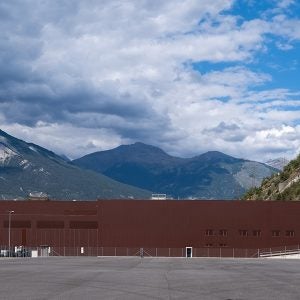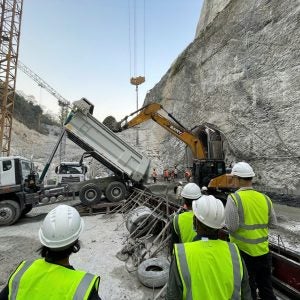On a balmy day, the last one of the 2006, there was an air of festivity around the project site of the Sardar Sarovar dam, in India’s Gujarat state. The last bucket of concrete was being emptied ceremonially on the dam by the State’s Chief Minister, Narendra Modi, to mark the completion of the construction work on the giant dam, built across the Narmada river. Only the radial gates needed to be installed at the structure, which would raise its height to the designed 138.68m.
The completion of the main structure has taken two long decades from the year that the work was initiated on the project as it is presently designed (Table 1), and even longer from the time that it was first mooted – in a much more modest form – in 1961. Named after the late Sardar Patel, the State’s most noted freedom-fighter against the colonial rule (and later to be the first Deputy PM in the independent India), Sardar Sarovar is the biggest multipurpose, river-valley project to have been undertaken in western India – and also one of the biggest in the sub-continent.
The press promptly hailed it ‘completion’ of the dam. Yet, despite the time taken and an expenditure of about US$5.25B incurred, much still remains to be done – not only at the dam, but also on some of its components – before the State-owned project company, Sardar Sarovar Narmada Nigam Ltd (SSNNL) can rest easy.
Here, a quick look at the context of the project would be useful. Of the west-flowing rivers in India (which empty into the Arabian Sea), Narmada is by far the biggest, having a total length of 1312km. It originates in the State of Madhya Pradesh in central India, passes for most of its length in that state (forming, for a while, its boundary with Maharashtra state), before entering Gujarat for its final journey to the sea. Earlier plans for harnessing its waters did not materialise, mainly due to the dispute between these three riparian States over water-sharing. It took ten years (1969-79) of hearings before an inter-state body, Narmada Water Disputes Tribunal (NWDT), was set up by the federal government to make a final decision on the project and related issues. Some of the issues recognised by the NWDT were:
• With regards to the use of the Narmada river-basin, the Tribunal recommended the construction of 30 major dams (apart from 135 medium-sized and 3000 minor dams). Of the 30, all except one were to be built in Madhya Pradesh. The sole exception was Sardar Sarovar, which was to come up in Gujarat.
• The water-share of the three States under Sardar Sarovar was fixed respectively at 11.1Bm3, 308Mm3 and 22.5Bm3 for Gujarat, Maharashtra, and Madhya Pradesh. (A small share of 612Mm3 was to go to Rajasthan state, bordering Gujarat to its north).
• The ratio of power generated at Sardar Sarovar was fixed at 16:27:57 between these three riparian States.
• Priority was to be given in water-usage to irrigation, with power getting the second priority.
• The share of project costs between the states was to be in proportion to the respective benefits accruing to them.
• The full reservoir and maximum water levels of Sardar Sarovar main dam were fixed at 138.68 and 140.21m respectively. It also fixed the FSL of the main canal at its head at 91.44m.
Sardar Sarovar at its full reservoir level would cause the submergence of 37,690ha belonging to 245 villages spread over the three States: 193 in Madhya Pradesh, 33 in Maharashtra, and 19 in Gujarat. Issues related to the ecology as resettlement of project-affected families (PAFs) have however caused some concern, and these issues have been raised vociferously by some of the stakeholders. As work on Sardar Sarovar began, a non-governmental movement – Save Narmada Movement (NBA) – was set up to protest and highlight these issues. The group received worldwide publicity and their efforts, both agitational and legal, were to keep the work on Sardar Sarovar bogged down for years, as both the federal and state governments tried to counter or meet the various objections raised by NBA.
It was only in October 2000 that a crucial push was given to Sardar Sarovar, when India’s Supreme Court gave the go-ahead for the dam to be raised to 90m. For each subsequent phase of its construction beyond that, until the dam reached its design-height, the Court stipulated that the SSNNL would be required to get prior and specific permission of the inter-state Narmada Control Authority (NCA). In doing so, the latter would have to call for reports from sub-groups monitoring the resettlement and environmental protection activities, and satisfy itself of the adequacy of those measures. The Court concluded its orders by stating: ‘Every endeavour shall be made to see that the project is completed as expeditiously as possible’.
As per another direction given by the Supreme Court, in January 2001 NCA also ratified a new schedule for the completion of the dam. Under it, the penultimate phase to raise the height of the dam to 121.92m would be over in June 2004, and the final phase of installation of the gates by June 2005. This was, however, not to be and right from the beginning, the work fell behind schedule, due mainly to the difficulties encountered in resettlement work, particularly in Madhya Pradesh. The NBA pointed to the unsatisfactory nature of the work, both in quantity and quality, resumed agitation and again approached the Supreme Court. The latter, while once again refusing to stop construction, asked the federal government in April 2006 to investigate the complaints and take suitable action. A three-member panel appointed by the government for this purpose recommended in July 2006 a set of measures to improve and speed up resettlement work in Madhya Pradesh. Subsequently, having gained clearance from NCA and a nod from the Prime Minister, SSNNL completed that phase on 31 December 2006. Construction of the concrete gravity main dam, up to the crest spillway and reaching the height of 121.92m, was finally accomplished.
However there still remains the task of installing the 30 radial gates on the dam. As it would further raise the height and cause additional submergence, SSNNL needs to get the approval of NCA under the Supreme Court’s earlier orders. Gujarat’s Chief Minister has reportedly already got in touch with his counterparts in the other two states to reach a consensus. To attain this, Madhya Pradesh state would need to complete work on the earlier phases of resettlement, while also aiding the estimated 15,000 new families to be affected in the last phase. From all accounts and based on past experience, this is not likely any time soon. In an interview with the author, Mr. P K Laheri, Chairman of SSNNL stated that he ‘can not give a firm date in this matter’ (see above).
Power generation
The power generation component of SSP has an installed capacity of 1450MW of hydro power. This is contained in two power stations, the commissioning of which was delayed for many years due to non-availability of water (following the dam-completion delay), differences with equipment-suppliers, and shortage of funds, etc. In the event, both the stations were progressively completed and began to generate increasing quantities of energy, even ahead of the completion of the main dam. They were ‘dedicated to the nation’ in a formal ceremony held at the Sardar Sarovar project in January this year.
Canal Head power house (CHPH)
The smaller of the two power stations, it is located above ground, at the toe of a saddle dam on the right bank of the project reservoir. It has an installed capacity of 250MW, comprising five conventional 50MW Kaplan units. CHPH was completed back in 1997, but could not be commissioned due to shortage of water in the reservoir. A height of at least 110.64m in the main spillway was needed before there was enough water for it to at least start operating. This was only reached in August 2004. Almost seven years after it was completed, the five units were progressively commissioned between August-December, 2004, and started generation from that fiscal year, 2004-05. The units are however still only generating at 34MW, and require the main dam to reach its full height of 138.68m before they get all the water that they need for full operation.
River-Bed power house (RBPH)
Located about 165m downstream of the dam, it is an underground power house, sited on the right bank of the river. It has an installed capacity of 1200MW, comprising six Francis reversible-type turbine-generator sets of 200MW each. These were supplied by Sumitomo of Japan and BHEL of India and were progressively commissioned between February 2005-June 2006. RBPH can generate power at its full capacity even with the present dam-height of 121.92m. In off-peak hours, the reversible units operate in the manner of a pumped storage scheme.
Transmission
The electricity generated at both power houses is carried to the 400kV switchyard located at RBPH. It is of indoor type, having gas-insulated switchgear and bus bars. Four 400kV double-circuit transmission lines, already commissioned, carry the generated power to the three beneficiary states of Gujarat, Maharashtra and Madhya Pradesh. Up to mid-March 2007, the two power stations had together generated an aggregate 5.7MGWh of electricity. The operation and maintenance of the power complex is entrusted to the State-owned Gujarat State Electricity Company, under contract with SSNNL.
Status of other components
Main canal – This has been completed up to 357km, and water released in that portion. The work on the remaining 101km is in progress and is likely to be completed during the current fiscal (beginning April 1).
Branch canals – Out of 38 canals (total length 2585km), 24 (1555km) have been completed. The work on the remaining canals is due for completion by mid-2007.
Distribution system – As per the data given by SSNNL, ‘most of the work’ for Phase-I of the system, i.e. up to 144km is completed, with the rest in progress.
Pumping stations – Water to the drought-prone Saurashtra area in Gujarat is to be supplied by lifting it into the Saurashtra Branch Canal. Five pumping stations were to be installed at various places along that Canal, of which one was commissioned in March this year.
Effects of the delays
• The further delay in the main dam reaching its full height means lesser availability of water in the reservoir for usage in power generation, irrigation, etc.
• Non-completion of the main canal means that for one more summer, Narmada water would not be available to the neighbouring State of Rajasthan.
• Lack of adequate quantity of water for Saurashtra Branch Canal would delay its supply to the parched areas of northwest Gujarat.
• Until all the work on the branch canals and distribution system is complete, the full benefits of Sardar Sarovar will not be available to the people of Gujarat.
• The total cost of Sardar Sarovar will rise even further, from the US$5.25B already spent on it to January 2007.
As per a recent report of SSNNL, ‘all the works of the project are planned to be completed by 2010, which is the golden [jubilee] year of the creation of Gujarat State.’
Sardar Sarovar dam, under construction in India Sardar Sarovar dam Table 1 Table 2 Mr P K Laheri, Chairman and MD, SSNNL Mr P K Laheri Interview with Mr P K Laheri, Chairman and MD, SSNNL
Q. The judgment of Supreme Court in favour of the project was given in October 2000. What were the main reasons for the further delay in completing the construction work on the main dam by over six years?
A. The judgement of the Supreme Court required the Narmada Control Authority to furnish a plan of completion of Sardar Sarovar dam including installation of gates. According to the plan submitted by NCA to the Supreme Court, the work was to be completed by June 2006. We are short of one level i.e. installation of Gates. The delay, as it is well known, is on account of issues connected with rehabilitation of project affected families in Madhya Pradesh and Maharashtra.
Q. When do you think SSNL would be in a position to commence installation of the gates, and how much time would it take to finish the work to reach the projected height?
A. Your question depends on progress of rehabilitation and hence, I cannot give a firm date in this matter.
Q. Similarly, what deadlines have been fixed to complete the remaining Branch Canals and Distributaries? When would Rajasthan get Narmada water?
A. The Government of Gujarat has decided that all work related to distribution of water in Command Area would be completed before end of 2010.
Water of Narmada will reach Rajasthan before the end of this calendar year.
Q. What is being done to fill the funds-deficit and to finance the remaining works?
A. The Government of Gujarat has accordingly raised allocation to as high as Rs.3015 crores in the current year’s budget. As mentioned above, the Government is giving full support to the project to complete the remaining works. At the moment, all payments are on line and there is no difficulty of cash flow.
Q. Will SSNNL continue to exist after the Narmada Project is completed, or would its O&M work be done in the normal course by Gujarat government departments?
A. SSNNL was incorporated to implement the project. The Articles have been amended by Government of Gujarat to continue operation of the project through SSNNL. What will be the future arrangements depends on the decision of the Government at that time and we cannot speculate on that.
I M Sahai is an independent consultant in hydro power, based in New Delhi






